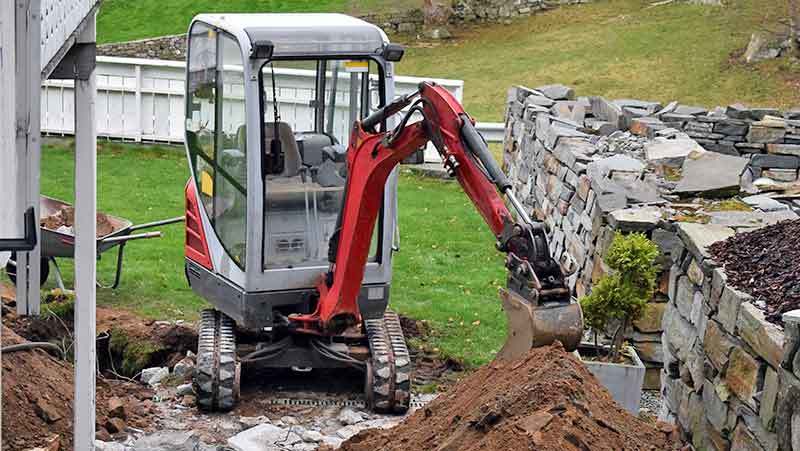
Why and How to use a Mini Excavator?

As the name suggests, 'Mini Excavator' is a compact version of a standard excavator. It is an essential piece of machinery for any construction and demolition project. Although the word 'mini' is attached to its name as a prefix to a physical description, that word does no justice to the wide range of operational facilities provided by it to the business.
Being lighter in weight and smaller in size in comparison to a standard excavator, it becomes ideal and cost-reducing equipment for small to medium scale projects. Its ability to make its way in a small space or a crowded area gives it an upper hand over a regular-sized excavator. Moreover, its compact size contributes to lesser wear and tear due to the intensive workload. This facilitates a longer life for the mini excavator without any extra cost of maintenance.
A variety of reasons why mini excavators are used are:
1. Versatility
A wide range of operations performed by a mini excavator is proof of its versatile nature. Be it digging trenches, clearing snow from roads during heavy snowfall or a small-scale demolition, a mini excavator is a key to it all. It is useful in heavy snowfall as well as in extreme heat. Its ability to have variable attachments makes it easy for users to put it to work in different situations, types and volume of work depending on the nature of the task at hand. The multiplicity of uses makes this equipment accessible.
2. Compact size
Do not let the small size of a mini excavator fool you! Its small size is the reason it can conveniently fit into confined spaces where a standard excavator or other larger machines cannot. For job sites which have narrow streets or are located in the interior parts of a city, a mini excavator is go-to machinery for getting the work done. A smaller body frame and lesser weight also make it a better choice for working on soft ground.
3. Higher efficiency
When compared to a standard excavator, a mini excavator requires much lesser fuel for functioning and releases lesser emissions. This acts as a cost-reducing way to cut down the running expensive incurred for the job in hand. Apart from this feature, setting the engine's RPM prevents wastage of extra fuel consumed by the machine without any additional output. As a result, optimum utilization of resources is possible. The hydraulic system also provides a better cycle time and increases productivity.
4. Lower the Cost
For any business, the bottom line is to get the work done at minimum cost. For small and medium-scale projects, a mini excavator is preferable due to its lower cost. They achieve the desired results without putting too much burden on the capital investment budget of the business. It also has lesser fuel intake requirement and a lower rate of wear and tear, which reduces the variable costs such as repair and replacement costs.

Here are some steps to follow to have a basic understanding of how to use a mini excavator:
1. Choose the right kind of mini excavator
Before proceeding to the steps of how to practically use a mini excavator, it is very important to the right kind of machinery chosen for the work to be done. The correct weight of the machine required is mostly determined by the texture of the ground i.e. whether it is rough or soft. Also, the lifting capacity of the mini excavator should be determined by the approximate weight and intensity of the work.
2. Familiarize with the controls of the machine
It is essential to read the user instruction manual, which comes along with the machine during delivery. Have a clear idea of what each lever is for. The instructions given in the manual are usually detailed descriptions of how to operate the machine. This prepares the user for all the steps to be followed for the practical application of the steps. The precautions mentioned in it are to be read and remembered diligently in order to avoid any uneventful accident or emergency. The basics like the use of right and left levers for movement of the boom and arm are given in there.
3. Comply with the safety measures
Any user should know the conditions were using the machine might be hazardous. Checking for oil leaks in the fuel tank and the level of coolants should be done before use. It is necessary where the fire extinguisher is placed in case of a fire. Putting on a seatbelt before starting the machine is an essential safety requirement. These steps assure greater security to the user as well as the machine.
4. Turn the mini excavator on
This is quite similar to turning on commercial vehicles. Insert the key in the ignition and turn it right to switch the machine on for use.
5. Test the control before use
After reading the user's instruction manual, a user should test his/her knowledge by putting the theoretical understanding to a practical test. The controls and levers should be operated to test the ease with which it is working and to get into the headspace of working with a heavy machine. This reduces the chance of accidents and gives the user an unrestricted movement while working with it.
6. Practice driving and get well trained
After mastering the use of controls, getting the hang of driving a machine as heavy as a mini excavator is essential. It should usually be done in a large, open space which is scarcely surrounded by people for safety reasons. Some other training regarding the professional use of a mini excavator for its proper usage is needed.
Though a layperson can follow these steps, it is advised to let heavy machinery like a mini-excavator be used by a trained professional for maximum output and safety. Thus, we can conclude that a mini excavator delivers high performance.
Our checklist on excavator maintenance should can help guide you to own an efficient equipment and avoid unexpected failures, downtime, and costly repairs.
 Construction Equipment
Construction Equipment
 Cranes
Cranes
 Material Handling
Material Handling
 Trucks & Trailers
Trucks & Trailers
 Vehicles
Vehicles
 Agricultural Equipment
Agricultural Equipment
 Live Auctions
Live Auctions












